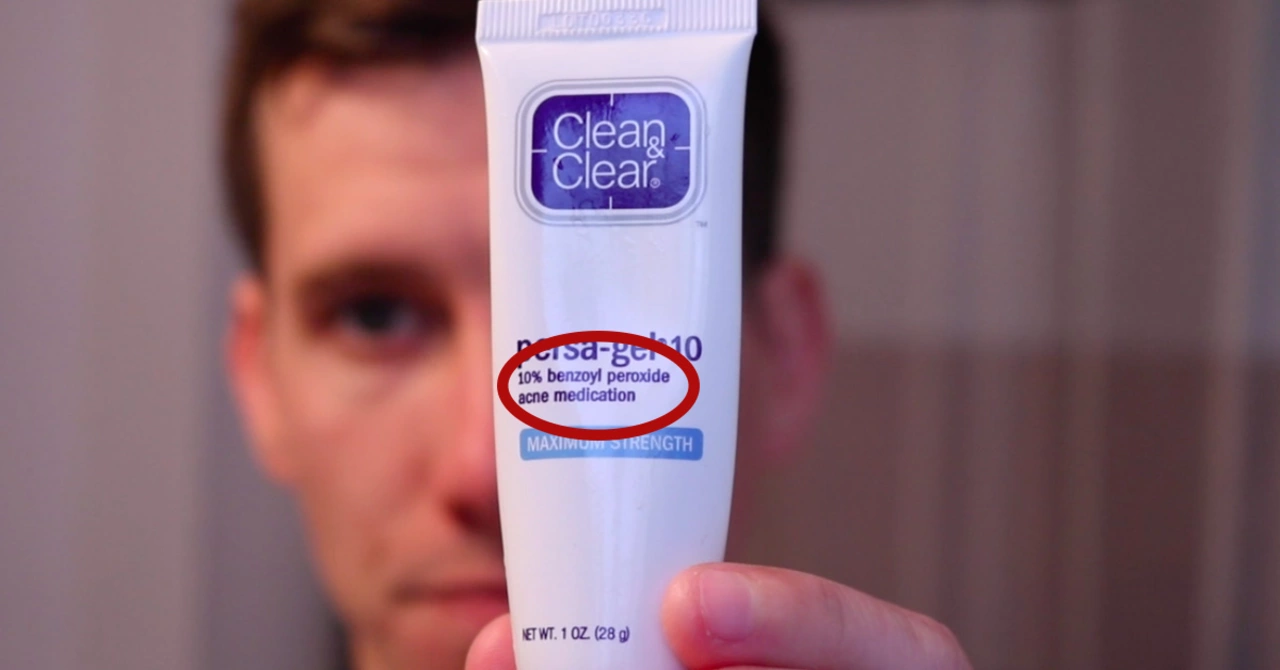Benzoyl Peroxide: An Ingredient to Avoid for Rosacea Sufferers?
Understanding Rosacea and its Triggers
Rosacea is a common skin condition that affects millions of people worldwide. It is characterized by redness and visible blood vessels on the face, and in some cases, it can cause bumps and pimples. While the exact cause of rosacea is still not fully understood, several factors are known to trigger or worsen its symptoms, such as exposure to sunlight, hot or cold weather, spicy foods, alcohol, and certain skincare ingredients. One of these ingredients is benzoyl peroxide, which is commonly found in acne treatments.
As a rosacea sufferer myself, I understand how frustrating and confusing it can be to navigate the world of skincare, trying to find products that won't exacerbate our condition. In this article, I will delve into the reasons why benzoyl peroxide might be an ingredient to avoid for those with rosacea, as well as offer some alternative solutions for maintaining healthy and balanced skin.
The Role of Benzoyl Peroxide in Skincare
Benzoyl peroxide is a popular ingredient in many over-the-counter and prescription acne treatments. It works by killing the bacteria that contribute to acne and by helping to unclog pores, making it effective in reducing the occurrence of pimples and blackheads. Due to its powerful antibacterial and exfoliating properties, benzoyl peroxide is often considered a go-to treatment for those struggling with acne-prone skin.
However, it is essential to understand that while benzoyl peroxide can be beneficial for some skin types, it may not be suitable for everyone, particularly those with rosacea. In fact, using products containing benzoyl peroxide can sometimes worsen rosacea symptoms, leading to increased redness, irritation, and inflammation.
Why Benzoyl Peroxide May Not Be Suitable for Rosacea Sufferers
The reason benzoyl peroxide may not be the best choice for rosacea sufferers lies in the way it works. As I mentioned earlier, it is a potent antibacterial and exfoliating agent. This means that it can be quite harsh and drying on the skin, especially when used in higher concentrations or when applied frequently. For people with rosacea, who often have sensitive and easily-irritated skin, using benzoyl peroxide could lead to increased redness and inflammation.
Furthermore, benzoyl peroxide can also cause a burning or stinging sensation when applied to the skin, which might be particularly uncomfortable for those with rosacea. Additionally, its exfoliating properties can sometimes cause the skin to become dry and flaky, which is not ideal for rosacea sufferers, as our skin often needs extra hydration and gentle care to remain balanced and healthy.
Alternative Skincare Ingredients for Rosacea Sufferers
If you're a rosacea sufferer looking for skincare products that won't exacerbate your symptoms, it's important to look for gentle, hydrating, and soothing ingredients. Some alternatives to benzoyl peroxide that may be beneficial for rosacea-prone skin include:
- Niacinamide: This form of vitamin B3 has anti-inflammatory properties and can help to strengthen the skin's barrier function, making it an excellent choice for calming redness and reducing irritation.
- Azelaic Acid: This naturally-occurring acid has antibacterial, anti-inflammatory, and antioxidant properties, making it a suitable alternative to benzoyl peroxide for treating acne and rosacea symptoms.
- Centella Asiatica Extract: Also known as Gotu Kola, this plant extract has been shown to have soothing and healing properties, making it a great option for calming irritated and inflamed skin.
- Green Tea Extract: Rich in antioxidants and anti-inflammatory compounds, green tea extract can help to protect the skin from environmental stressors and reduce redness and inflammation.
- Aloe Vera: This natural ingredient has long been known for its soothing and hydrating properties, making it an excellent choice for calming rosacea-prone skin.
Final Thoughts: Tailoring Your Skincare Routine to Your Needs
As a fellow rosacea sufferer, I know how important it is to find skincare products that work for our unique needs. While benzoyl peroxide may be an effective acne treatment for some, it might not be the best choice for those of us with rosacea-prone skin. Instead, consider looking for alternative ingredients that can help to soothe, hydrate, and protect our delicate skin without causing further irritation or inflammation.
Of course, everyone's skin is different, and what works for one person may not work for another. So, it's essential to listen to your skin and adjust your skincare routine as needed. If you're unsure about which products or ingredients are right for you, consider consulting with a dermatologist to help guide your skincare journey and ensure that you're giving your skin the best possible care.







10 Comments
joba alex
May 6, 2023 at 22:52
Bz peroxide is just a red hot mess for rosacea.
Rene Lacey
May 8, 2023 at 16:32
When we contemplate the delicate equilibrium of the dermal ecosystem, we must first acknowledge that skin is not merely a barrier but a living, communicative organ that engages in constant dialogue with its environment. The introduction of a potent oxidizing agent such as benzoyl peroxide disrupts that dialogue, sending shockwaves through the microbiome, which in turn can amplify the vascular hyper-reactivity characteristic of rosacea. One might argue that the antibacterial merits of this compound are undeniable for acne, yet the same mechanism that annihilates Propionibacterium acnes also erodes the protective lipids that cushion our capillaries. This erosion precipitates a cascade: loss of barrier function leads to transepidermal water loss, which invites dryness, and dryness invites inflammation, completing a vicious circle that is particularly unforgiving to rosacea-prone skin. Moreover, the oxidative stress inflicted by peroxide can stimulate the production of reactive oxygen species, which act as molecular saboteurs, destabilizing cellular membranes and prompting the release of pro‑inflammatory cytokines. In philosophical terms, we are witnessing a classic case of utilitarian trade‑offs, where the benefit to one subset of skin conditions is outweighed by the harm to another. The ethical consideration, then, becomes whether we should impose a one‑size‑fits‑all solution upon a heterogeneous population of skin types. From a clinical perspective, the prudent path is to reserve benzoyl peroxide for those whose inflammatory pathways are dominated by acneic lesions, while seeking gentler, barrier‑supporting alternatives for those whose redness stems from neurovascular dysregulation. Indeed, the literature increasingly supports the use of niacinamide, azelaic acid, and centella asiatica as milder yet effective means of modulating inflammation without the collateral damage inflicted by harsh oxidizers. Finally, we must remember that patient autonomy and individualized care plans are paramount; a clinician’s role is to illuminate the risks and benefits, allowing the individual to navigate the therapeutic landscape with informed consent. In sum, while benzoyl peroxide remains a valuable tool in the dermatological arsenal, its deployment in rosacea should be approached with caution, lest we trade one form of discomfort for another.
johnson mose
May 10, 2023 at 10:12
Hey folks, just wanted to drop a quick note that there are plenty of gentler options out there for rosacea‑prone skin. 🌿 First up, niacinamide is a superstar: it calms inflammation, strengthens the barrier, and reduces that pesky redness. Azelaic acid is another champ – it tackles both acne and rosacea while being far less harsh than peroxide. If you love botanicals, centella asiatica (aka Gotu Kola) brings soothing, healing vibes that many find helpful. And don’t forget good old aloe vera – it’s the classic calm‑down after a flare. Bottom line: you don’t need to suffer just to keep acne at bay; a thoughtful combo can keep both concerns in check.
Charmaine De Castro
May 12, 2023 at 03:52
Great suggestions above! I’ve personally swatched a serum with both niacinamide and green tea extract, and it’s been a game‑changer for my rosacea flare‑ups. The antioxidants in green tea help keep the vasculature calm, while niacinamide repairs the barrier. Just remember to introduce new products slowly and patch‑test, especially if your skin is reactive.
Mark Mendoza
May 13, 2023 at 21:32
👍 Absolutely agree with the gentle alternatives. In my experience, starting with a low‑concentration azelaic acid (10%) can reduce both papules and persistent redness without the burning you get from benzoyl peroxide. Pair it with a moisturizer that contains ceramides for extra barrier support. 🌟
Dan Tourangeau
May 15, 2023 at 15:12
Nice tip! A ceramide‑rich cream is a solid follow‑up after azelaic acid.
Bernard Valentinetti
May 17, 2023 at 08:52
Whoa-let’s get real!!! Benzoyl peroxide? More like a daredevil’s nightmare!!! It screams “oxidative chaos”!!! If you love living on the edge, go ahead; otherwise, ditch it for something mellow-like, say, a humble niacinamide serum???!
Kenneth Obukwelu
May 19, 2023 at 02:32
Indeed, the cultural perception of “strong” ingredients often overshadows their potential for harm. In many societies, we celebrate the “hard‑core” approach, yet the skin’s narrative prefers balance. Opting for soothing botanicals respects both tradition and science.
Josephine hellen
May 20, 2023 at 20:12
Friends, let’s keep our spirits up as we navigate the skincare maze! 🌈 Remember, every flare is an opportunity to learn what truly loves your skin. Embrace the journey, celebrate small victories-like a day with less redness-and share those wins with the community. Positivity fuels resilience, and together we can turn the tide against irritation. Keep experimenting cautiously, stay patient, and never underestimate the power of a good moisturizer and a sunny disposition.
Ria M
May 22, 2023 at 13:52
Ah, the drama of dermal destiny! When the crimson tide of rosacea threatens to engulf our visage, we must summon the inner philosopher and ask: "What is the essence of tranquility for our epidermis?" The answer lies not in the aggressive blaze of benzoyl peroxide, but in the gentle whisper of centella asiatica, the serene embrace of aloe vera, and the steadfast guardianship of ceramides. Let us, therefore, cast aside the incendiary allure of peroxide and cherish the harmonious symphony of soothing botanicals.